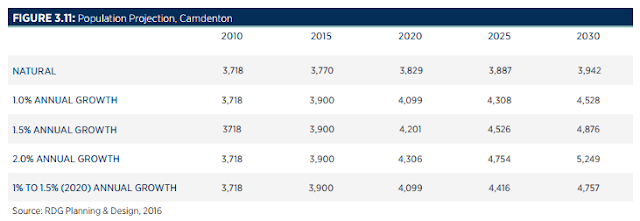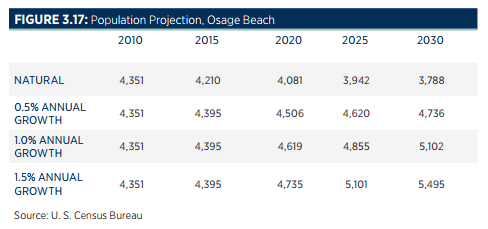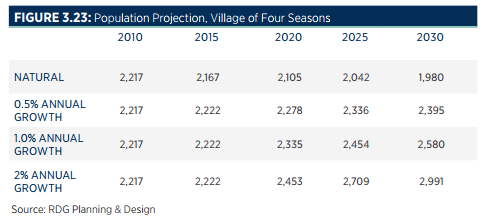2017 Regional Housing Study: Housing Demand in Camden County
As Lake of the Ozarks Regional Economic Development Council assembled economic development plans and initiatives for the region, housing has come up frequently as a major economic development factor. To be successful, the area must provide a variety of housing types to drawn in residents who want to relocate a business to the Lake of the Ozarks. The diverse economy of the region, which includes both tourism-oriented businesses close to the Lake and industrial jobs away from the Lake, has successfully attracted a growing population of people who seek to enjoy the environment offered in the region. This week, the Lake of the Ozarks Regional Economic Development Council wants to share how the housing demand will affect the growth of the Lake of the Ozarks region moving forward. Take a look:
PROFILE OF CAMDEN COUNTY
Over the past 30 years Camden County has experienced strong growth with its most significant growth in the 1990s. As the most populous county in the Lake of the Ozarks region, Camden County is a primary center for retail trade and healthcare. Camden County is more diverse than many perceive. The north portion of the county is dominated by the Lake and the economic benefits it creates, but the southern portion of the county is more rural with a mixture of agricultural uses and pockets of residential development. The county's strong job base creates some of the strongest housing demand in the region. This demand varies from second homes or retirement living near the Lake to housing for service workers and professionals.
POPULATION CHARACTERISTICS
The population characteristics and trends shine a light on current housing demand and provide a base for projecting future population and housing demand.
ECONOMIC CHARACTERISTICS
Camden County's outdoor recreation and lake living have allowed the region to weather the recession and experience a growing economy over the past several years. The region's economy has a significant impact on housing and housing demand. This includes demand for workforce housing, second homes, and retirement living. A basic assessment of Camden County's economic trends indicates:
As a center of regional health services and the largest school district in the Lake of the Ozarks area, many residents of the county are employed in educational services and healthcare.
Residents working in retail trade make up the second largest industry for county residents.
CAMDENTON
The second largest city in Camden County, Camdenton is a significant center of commerce and the community's services in the county. Home to the county seat and the county's largest school district, Camdenton has a demand for workforce housing that meets the needs of young families looking to establish roots in the region.
PRIMARY THEMES FOR CAMDENTON
During the last decade, Camdenton experienced a 2% annual growth rate (AGR). The recession likely slowed this growth along with a decrease in the number of available lots. The opportunity for new affordable lot development is limited. However, there are important opportunities within existing areas, such as Old Highway 5 for redevelopment and infill opportunities. To support a population of 4,416 by 2025 as projected, the city will need to produce 240 additional housing units. The city's housing demand (240 units) will need to include both new owner and renter occupied housing options. Approximately 75 new owner-occupied units should be priced below $130,000. Nearly 70 rental units will need to be produced with monthly rents below $700 per month.
OSAGE BEACH
Since the 1990s, Osage Beach has experienced significant growth in both population and commercial development. Investments by the city in sewer and water extensions have supported much of this growth. Lake oriented businesses and industries, like the hospital, will continue to support growth in the city.
PRIMARY THEMES FOR OSAGE BEACH
The city's housing demand includes a full range of housing types:
Over the next 15 years, the city's population is projected to grow. Infrastructure investments made by the city will likely support this development, however, affordable lots may continue to be an issue. Between 2000 and 2010, the city experienced a 3% annual growth rate, a rate that appears to have leveled off during the recession. This rate is substantial for any community and, when projecting a city's population, should be used cautiously because of the compounding nature of an annual growth rate. For this reason and the need to produce more lots to support development, a more conservative 1.0% annual growth rate is used to generate a 2030 population of 5,102.
VILLAGE OF FOUR SEASONS
Since it was incorporated, the Village of Four Season has grown rapidly. Most of this growth has consisted of higher value single-family residential developments. In the coming years, the Village and Property Owners Association (POA) could play a significant role in supporting the region's overall growth.
PRIMARY THEMES VILLAGE OF FOUR SEASONS
During the 1990s and 2000s, the Village experienced very high growth rates in the range of 4% to 5%. These levels will likely be difficult to sustain and current 2014 population estimates support this assumption. Over the next 15 years, the Village can reach a population of nearly 3,000 with a 2% annual growth rate. This rate could be higher if existing vacant lots are positioned for development. In order to sustain a 2% annual growth rate, the Village would have to produce approximately 26 housing units per year.
As the largest county in the Lake of the Ozark region, Camden County is the center of much of the region's commerce and jobs. Over the years, the employees filling those jobs have found housing across the entire region. As community and county leaders look for ways to continue to expand the local economy, housing will play a crucial role. The region is well positioned to continue to grow and be an attractive location for residents looking to relocate a business to Missouri and expand the economy. The county's health care and educational resources, in addition to the obvious asset the Lake provides, are all great positives!
PROFILE OF CAMDEN COUNTY
Over the past 30 years Camden County has experienced strong growth with its most significant growth in the 1990s. As the most populous county in the Lake of the Ozarks region, Camden County is a primary center for retail trade and healthcare. Camden County is more diverse than many perceive. The north portion of the county is dominated by the Lake and the economic benefits it creates, but the southern portion of the county is more rural with a mixture of agricultural uses and pockets of residential development. The county's strong job base creates some of the strongest housing demand in the region. This demand varies from second homes or retirement living near the Lake to housing for service workers and professionals.
POPULATION CHARACTERISTICS
The population characteristics and trends shine a light on current housing demand and provide a base for projecting future population and housing demand.
ECONOMIC CHARACTERISTICS
Camden County's outdoor recreation and lake living have allowed the region to weather the recession and experience a growing economy over the past several years. The region's economy has a significant impact on housing and housing demand. This includes demand for workforce housing, second homes, and retirement living. A basic assessment of Camden County's economic trends indicates:
As a center of regional health services and the largest school district in the Lake of the Ozarks area, many residents of the county are employed in educational services and healthcare.
- Housing demand for these residents often includes quality market rate rentals as they are entering the market and smaller entry level owner occupied housing. Most of these employees are looking to live away from the Lake in environments that are family friendly.
Residents working in retail trade make up the second largest industry for county residents.
- Retail positions tend to offer lower wages at, or just above, the minimum wage. These residents will need more affordable housing options, including some housing assistance depending on the size of the household.
CAMDENTON
The second largest city in Camden County, Camdenton is a significant center of commerce and the community's services in the county. Home to the county seat and the county's largest school district, Camdenton has a demand for workforce housing that meets the needs of young families looking to establish roots in the region.
PRIMARY THEMES FOR CAMDENTON
During the last decade, Camdenton experienced a 2% annual growth rate (AGR). The recession likely slowed this growth along with a decrease in the number of available lots. The opportunity for new affordable lot development is limited. However, there are important opportunities within existing areas, such as Old Highway 5 for redevelopment and infill opportunities. To support a population of 4,416 by 2025 as projected, the city will need to produce 240 additional housing units. The city's housing demand (240 units) will need to include both new owner and renter occupied housing options. Approximately 75 new owner-occupied units should be priced below $130,000. Nearly 70 rental units will need to be produced with monthly rents below $700 per month.
OSAGE BEACH
Since the 1990s, Osage Beach has experienced significant growth in both population and commercial development. Investments by the city in sewer and water extensions have supported much of this growth. Lake oriented businesses and industries, like the hospital, will continue to support growth in the city.
PRIMARY THEMES FOR OSAGE BEACH
The city's housing demand includes a full range of housing types:
- Housing for seasonal workers filling service and retail positions during the summer months.
- Entry level workforce housing for staff at the hospital that includes a full range of hourly workers.
- Higher level earners coming to fill professional positions in the area and looking for family oriented housing located away from the Lake.
- Seniors wanting to move or remain in the area, but no longer interested in the maintenance of a home right on the Lake. Arrowhead Centre will begin to fill some of this need.
Over the next 15 years, the city's population is projected to grow. Infrastructure investments made by the city will likely support this development, however, affordable lots may continue to be an issue. Between 2000 and 2010, the city experienced a 3% annual growth rate, a rate that appears to have leveled off during the recession. This rate is substantial for any community and, when projecting a city's population, should be used cautiously because of the compounding nature of an annual growth rate. For this reason and the need to produce more lots to support development, a more conservative 1.0% annual growth rate is used to generate a 2030 population of 5,102.
VILLAGE OF FOUR SEASONS
Since it was incorporated, the Village of Four Season has grown rapidly. Most of this growth has consisted of higher value single-family residential developments. In the coming years, the Village and Property Owners Association (POA) could play a significant role in supporting the region's overall growth.
PRIMARY THEMES VILLAGE OF FOUR SEASONS
During the 1990s and 2000s, the Village experienced very high growth rates in the range of 4% to 5%. These levels will likely be difficult to sustain and current 2014 population estimates support this assumption. Over the next 15 years, the Village can reach a population of nearly 3,000 with a 2% annual growth rate. This rate could be higher if existing vacant lots are positioned for development. In order to sustain a 2% annual growth rate, the Village would have to produce approximately 26 housing units per year.
As the largest county in the Lake of the Ozark region, Camden County is the center of much of the region's commerce and jobs. Over the years, the employees filling those jobs have found housing across the entire region. As community and county leaders look for ways to continue to expand the local economy, housing will play a crucial role. The region is well positioned to continue to grow and be an attractive location for residents looking to relocate a business to Missouri and expand the economy. The county's health care and educational resources, in addition to the obvious asset the Lake provides, are all great positives!
Please subscribe to our blog and enjoy!
1000 City Parkway
Osage Beach, MO 65065
573-569-7420









Comments
Post a Comment